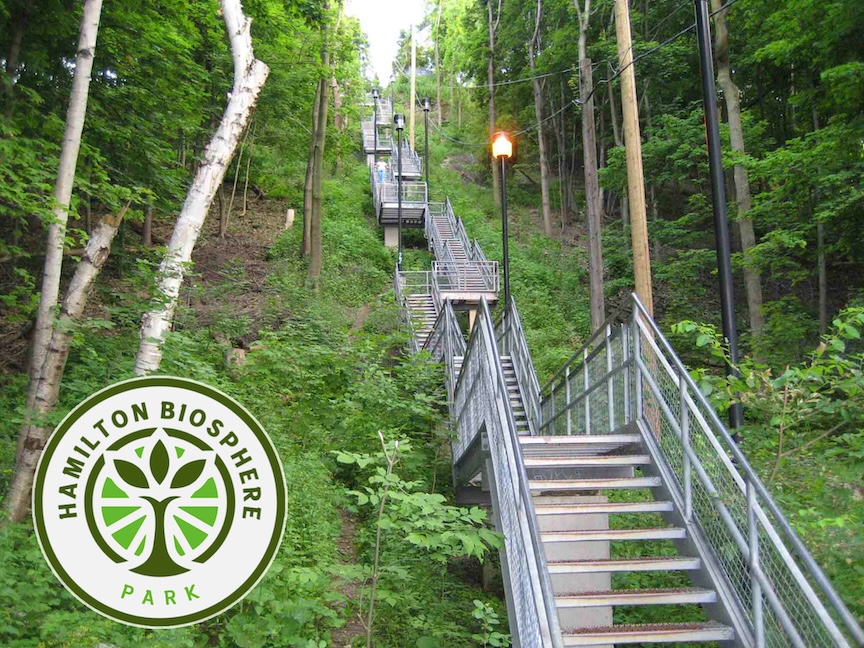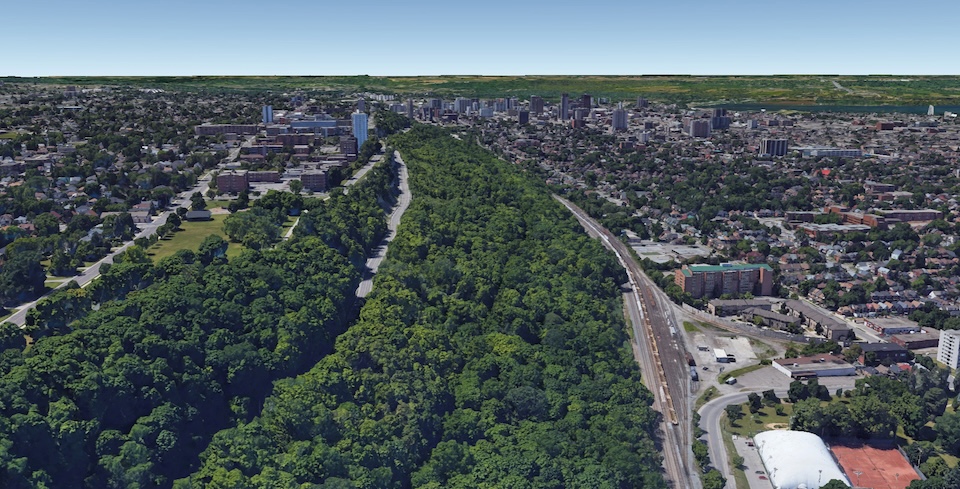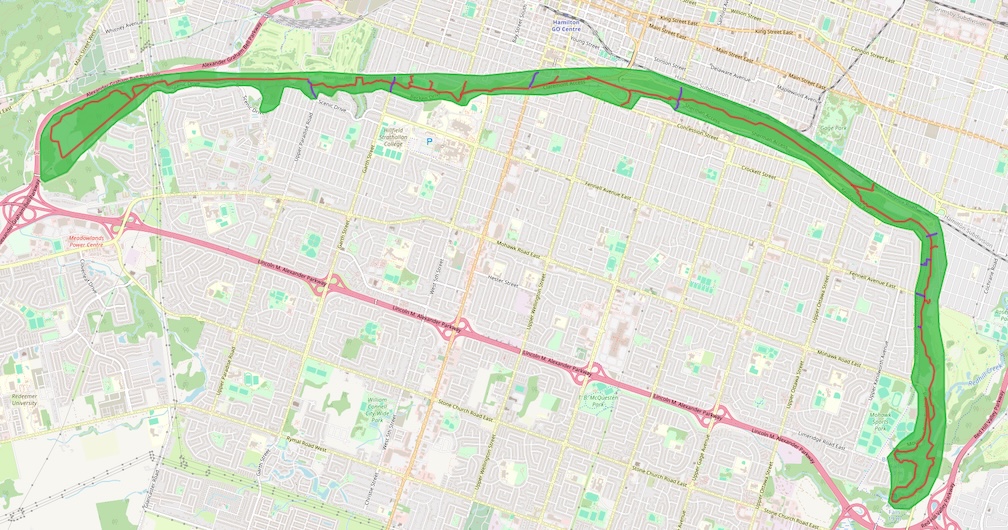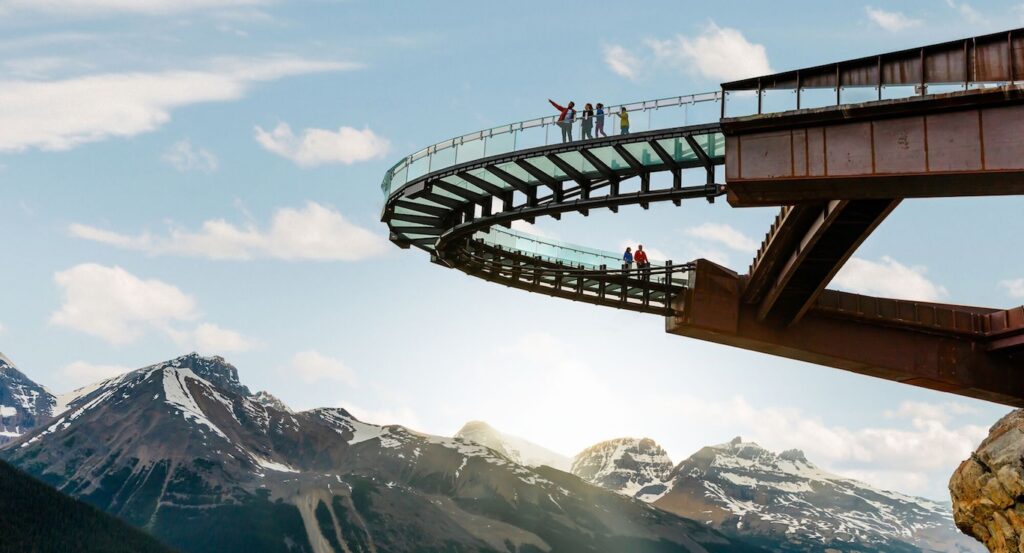The Hamilton Biosphere Park: A new eco-destination

There is an internationally recognized ecological gem running right through the middle of our city. It’s time to recognize the fabulous opportunity before us to celebrate and protect the Niagara Escarpment.
“This is amazing!”
“The views are incredible.”
“It’s so close to neighbourhoods.”
“I never knew Hamilton had this.”
These were just a few of the responses from out-of-town visitors who attended a hike last year. It was during the Ontario professional planners conference, where I had the opportunity to co-lead an outdoor tour that led participants from the top of the Niagara Escarpment, down the rail trail, across Chedoke golf course, through the streets of the Kirkendall neighbourhood, and finally stopping at the businesses of Locke Street South. The whole trek took about an hour, but the variety of locations that transition from towering trees in nature to urban storefronts, made it seem longer. You could feel you were 100 km out of the city, and in a matter of mere minutes, find yourself in the middle of a thriving business district.
The lasting impression from the visitors was that Hamilton was lucky to have this greenspace and that it should not be taken for granted.
Thinking back to that tour, and the genuine reaction of those who experienced it for the first time, revealed how much this part of the city is taken for granted by those who live here. That’s not to say it’s not loved by many. Whether it’s the trails or staircases, Hamiltonians use this space daily. However, there is a sense that the escarpment is a somewhat overlooked area of the city when it comes to planning, conservation and investment.

All images: Paul Shaker/Civicplan
First, we need to consider what area we are talking about. In Hamilton, the Niagara Escarpment is the band of green space that divides the upper and lower city. But it’s actually more than just another green space. It’s a landmark that has been designated a World Biosphere Reserve by the United Nations Educational, Scientific and Cultural Organization (UNESCO). There are a limited number of reserves around the globe that belong to the World Network of Biosphere Reserves. In Canada, other reserves include Clayoquot Sound on the west coast and Fundy on the east coast. While the full Niagara Escarpment runs from Niagara to Tobermory, what is unique about this biosphere reserve is that it is one of the few that travels directly through the centre of a major Canadian city: Hamilton.
What are biosphere reserves? They are internationally designated protected areas that are meant to demonstrate a balanced relationship between people and nature. They are learning areas for sustainable development under diverse ecological, social and economic contexts. This definition provides a perfect aspiration for Hamilton in its relationship to nature.
When it comes to repairing and enhancing our connection with nature, Hamilton has adopted specific goals. For example, the Biodiversity Action Plan, passed in 2024, aims to protect, enhance, explore and restore biodiversity in Hamilton. Simply put, biodiversity is the variety of life on Earth. Hamilton happens to be a biodiversity hotspot with many unique habitats that support hundreds of common and many at-risk species. Biodiversity supports many elements of everyday life, including the cleaning of our air and water and providing spaces for us to explore and engage with nature. Unfortunately, biodiversity is in decline globally and locally due to a growing number of threats, including climate change and habitat loss. The Biodiversity Action Plan will help focus the efforts of the municipality and the local conservation community to work together to enact change, including actions to protect, restore, connect and explore biodiversity in Hamilton.

So, this brings us back to the Hamilton portion of the Niagara Escarpment. Within this biodiversity context, and given the scale of the ecological asset we are dealing with, we need to do more; more to restore, connect and make it easier to explore this area of the city.
As it stands, many parts of this greenspace are not well maintained. Signs are missing or faded, trail entrances are unmarked or overgrown. Garbage is strewn about. Graffiti can be found on some of the ancient rocks. Perhaps it’s because this strip of land that divides the upper and lower city is squeezed between city wards, so responsibility for the space is somewhat unclear. From north to south, the escarpment continues to travel beyond the city limits so maybe there is a sense that we are just one spot along a much larger route. Whatever the reasons, there is unrealized potential here. Not just on an ecological or biodiversity front, but also from a quality-of-life and tourism perspective. There is a giant opportunity to make this a new major city eco-destination. To elevate this space to the forefront of city planning and treat it as the defining feature it truly is.
The Hamilton Biosphere Park

Much like other greenspaces in Hamilton, this part of the city should be formally designated a park. A unique park, something not found in any other city in this part of the country. Right now, the space lacks any sense of cohesive identity, but making it a park opens the door to proper planning. Geographically, this park could span the area of the escarpment between the two river valleys on either side: Chedoke and Red Hill. This encompasses roughly 16 kilometres of trails. There are a number of staircases connecting the upper and lower city that provide a unique opportunity to climb through the biosphere. Adjacent neighbourhoods give tens of thousands of residents quick access to the park. Of course, there are spectacular waterfalls to enjoy, and throughout the journey across the city, countless memorable views.
This park would embody the core goal of a UNESCO Biosphere Reserve – to demonstrate a balanced relationship between people and nature. This could mean that there needs to be areas that are protected from use, to allow regeneration. No more free-for-all travel with zero understanding of the potential harm we are doing to the ecosystem. The trail network, including entrances and trailheads, should be clearly marked to avoid the random cut-throughs that exist.
From a tourism perspective, providing unique experiences where visitors can responsibly enjoy and learn about the ecosystem should be the goal. On this front, we should think big and use inspiration from elsewhere as a guide. Vancouver’s Stanley Park offers an example of a natural forested oasis within an urban setting. Jasper National Park has the Columbia Icefield Skywalk, which allows visitors to walk out on an extended lookout platform to experience fossils, waterfall views and incredible landscapes. Similarly, Dorrigo National Park in Australia offers a Skywalk lookout in the form of a 70-metre boardwalk that soars over the edge of their escarpment, offering a bird's-eye view of the surrounding landscape. Could something like this be adapted for Hamilton’s Biosphere Park?
To begin to think of ideas like this, we need to first recognize the ecological gem we have here in Hamilton with the Niagara Escarpment. Its beauty is instantly recognized by people who visit, and it’s time we give it the status it deserves through the creation of a Hamilton Biosphere Park.
Paul Shaker is a Hamilton-based urban planner and principal with Civicplan.















